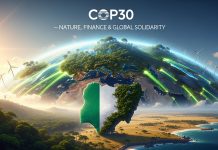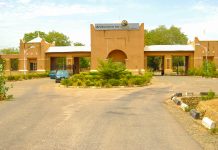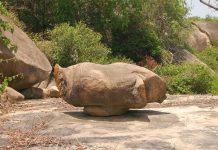Chad Basin National Park is a prominent protected area in northeastern Nigeria, covering approximately 2,258 square kilometres across Borno and Yobe States. The park comprises three main sectors: Chingurmi-Duguma, known for its rich savanna ecosystems and diverse wildlife; the Bade-Nguru Wetlands, an important habitat for migratory birds; and the Bulatura Oases, featuring unique desert landscapes. The park is home to various species, including giraffes and ostriches, and plays a crucial role in conservation efforts. Visitors can enjoy activities like birdwatching, wildlife viewing, and exploring the nearby Lake Chad. Access is typically via Maiduguri, the nearest city, making it an intriguing destination for eco-tourism and nature enthusiasts.

Overview
Geographic Location and Historical Significance
Chad Basin National Park is situated in northeastern Nigeria, spanning Borno and Yobe states. Covering approximately 2,258 km² within the Sudano-Sahelian ecological zone, the park lies in the historical region of the former Kanem-Bornu Empire, which thrived from the 9th to 19th centuries. Established in 1991, the park reflects the area’s rich cultural and ecological heritage.
Landscape and Natural Features
The park’s diverse terrain includes savanna woodlands, wetlands, and scenic sand dunes. The Chingurmi-Duguma sector, the largest, features Acacia-Balanites woodlands and seasonal floodplains that attract vibrant birdlife. The Bade-Nguru Wetlands, a critical part of the Hadejia-Nguru Wetlands, serve as a stopover for migratory birds and include the Dagona Waterfowl Sanctuary. The Bulatura Oases, with fertile dune depressions, host unique desert wildlife like giraffes and ostriches.
Current Status and Challenges
Managed under IUCN Category II, Chad Basin National Park prioritizes conservation and sustainable tourism. However, it faces significant challenges, including habitat degradation and insecurity, which have limited research and visitor access. Despite its ecological richness, deteriorating infrastructure and management issues have impacted its appeal to tourists.
A Brief History
Chad Basin National Park’s roots can be traced to the Kanem-Bornu Empire, a significant West African state established before the 10th century. Centred around the Lake Chad Basin, this empire thrived as a hub of trade and governance from the 9th to the 19th century, rivalling the Songhai and Mali Empires.
The park’s lands, historically tied to the Kanem-Bornu legacy, were initially designated as a game reserve in 1975 under Borno Province and were later elevated to national park status in 1991. It was formed by combining areas such as the Chingurmi-Duguma Game Reserve and Bade-Nguru Wetlands, aiming to preserve its ecological and historical heritage.
International recognition came with visits from Prince Philip in 1989 and Prince Charles and Princess Diana in 1990, underscoring its cultural and environmental significance. Despite challenges, the park remains a key site for biodiversity conservation, bridging its rich history with efforts to protect its unique landscapes and wildlife.
Ecological Diversity
Flora
Chad Basin National Park boasts remarkable plant diversity, with over 700 documented species. The vegetation reflects the park’s varied ecological zones, ranging from savannas to wetlands. Dominant flora includes various acacia species and the iconic baobab tree, which thrive in the park’s drylands. Wetland areas are rich with aquatic plants such as papyrus and reeds, which flourish during seasonal floods. The park also supports a mix of annual grasses and perennial species, showcasing adaptability to fluctuations in water availability. This diverse plant life provides critical habitats for the park’s wildlife, sustaining the delicate balance of its ecosystems.
Fauna
The park is a haven for wildlife, harbouring an impressive array of species across its landscapes.
- Birds: Approximately 532 bird species, both resident and migratory, have been recorded. Key species include the black-crowned crane, a vulnerable resident, as well as the Arabian bustard and visiting Demoiselle cranes. The wetlands are particularly vital during migration, attracting large numbers of waders and white storks.

- Mammals: Chad Basin National Park supports 131 large mammal species. Among them are iconic animals such as giraffes and ostriches, which find their last stronghold in Nigeria here. Other notable species include gazelles, hippopotamuses, and Nile crocodiles.
- Reptiles and Aquatic Life: The wetlands teem with reptiles, such as monitor lizards, and various fish species that sustain local fisheries.
Visitor Experience
Chad Basin National Park offers visitors a blend of adventure, relaxation, and cultural discovery, making it one of Nigeria’s unique natural destinations.
- Wildlife Observation: The park provides opportunities to view iconic animals such as giraffes, ostriches, hippopotamuses, crocodiles, and clawless otters. Nature enthusiasts can tour its diverse habitats, from savannas to wetlands, for close encounters with these species.
- Birdwatching: The park is a birdwatcher’s paradise, with over 500 bird species, including black-crowned cranes, demoiselle cranes, guinea fowl, and migratory waders. The wetlands are particularly active during the dry season, drawing bird enthusiasts from around the globe.
- Outdoor Activities: Visitors can enjoy activities such as boating near Lake Chad, picnicking in scenic areas, and exploring the striking sand dunes at Bulatura Oases. The park’s fishing villages also offer unique insights into traditional livelihoods.

- Cultural and Photography Opportunities: Local communities provide a glimpse into life intertwined with the park’s natural environment, while the diverse landscapes and wildlife make for excellent photography.
The best time to visit is during the dry season (November to April) when wildlife is more visible and migratory birds populate the wetlands. Chad Basin National Park promises an unforgettable experience for nature lovers and adventure seekers alike.
Challenges and Conservation Outlook
Challenges
Chad Basin National Park is beset by various challenges, many of which arise from environmental, socio-economic, and governance pressures:
- Water Scarcity: The semi-arid location of the Lake Chad Basin leads to physical water scarcity, while inadequate technology results in economic water scarcity. These factors disrupt ecosystems and reduce biodiversity.
- Loss of Biodiversity: Declining water levels and environmental degradation have caused significant habitat loss, affecting fish, birds, and aquatic plants.
- Conflict and Human-Wildlife Interaction: Local communities depend on park resources for survival, leading to conflicts over grazing and fishing within park boundaries. Broader conflicts, including terrorism, exacerbate challenges.
- Desertification: Unsustainable land use and climate change drive desertification, reducing arable land and natural habitats.
- Weak Governance and Funding: Insufficient funding and weak management structures hinder effective conservation efforts, leaving the park vulnerable to illegal activities like wildlife trafficking, logging, and mining.
Conservation Outlook
Despite the challenges, several strategies offer hope for Chad Basin National Park’s future:
- Community Engagement: Integrating local communities into conservation programs can foster sustainable practices and improve relationships with park authorities.
- Integrated Management: Sustainable land-use systems that balance ecological health with human activities such as grazing and fishing can help achieve conservation goals.
- Regional Cooperation: Collaborative efforts among Lake Chad Basin countries can address transboundary issues like pollution and habitat degradation.
- Increased Funding: International support and investment can improve conservation initiatives, including compensatory schemes for local communities that promote biodiversity protection.
Strategic interventions that address these challenges can ensure the long-term sustainability of Chad Basin National Park.
Final Note
Chad Basin National Park stands as a testament to the beauty and resilience of Nigeria’s natural heritage. Despite facing numerous challenges, the park remains a vital sanctuary for biodiversity and a hub for eco-tourism. With concerted efforts in conservation, community engagement, and sustainable management, Chad Basin National Park has the potential to thrive as a beacon of ecological preservation and cultural significance. By safeguarding this treasure, we make sure that its legacy endures for future generations to cherish.

















